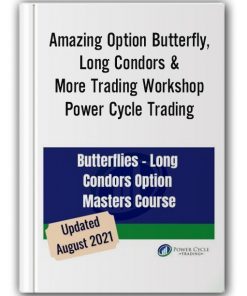Wyckoffanalytics – Point-And-Figure Part I + II + III
Original price was: $898.00.$84.00Current price is: $84.00.
This Course is available for download now. You can contact us for Screenshots or Demo. Access for this course will be sent on google drive. Join our telegram channel to see updates and occasional discounts. If you want to pay through Paypal or Card contact us – On Telegram Click Here or contact on Mail – [email protected]
Description
Author:Wyckoffanalytics
Richard Demille Wyckoff (1873–1934) was an early 20th-century pioneer in the technical approach to studying the stock market. He is considered one of the five “titans” of technical analysis, along with Dow, Gann, Elliott and Merrill. At age 15, he took a job as a stock runner for a New York brokerage. While still in his 20s, he became the head of his own firm. He also founded and, for nearly two decades, wrote and edited “The Magazine of Wall Street,” which at one point, had more than 200,000 subscribers.
Point-And-Figure Part I + II + III
Sale Page :wyckoffanalytics.com
This product is available
In Point-And-Figure Part I:
Roman and Bruce will cover:
– How to construct a Wyckoff-style P&F chart
– Basic Wyckoff P&F count guidelines and modern applications
– P&F Phase Analysis to predict shorter- and longer-term price objectives
– Using P&F counts in conjunction with bar charts to help time trade entries
Many AWC students and other traders have requested that we offer a course in Wyckoff Point and Figure analysis. This is that course!
Take advantage of this rare opportunity to learn about a central pillar of the Wyckoff Method!
In Point-And-Figure Part II:
Projecting Point-and-Figure Price Targets Across Multiple Time Frames, Bruce Fraser and Roman Bogomazov provide detailed instructions on how to create and use Wyckoff-based P&F charts to estimate realistic price targets. Anyone who has seen Bruce’s P&F analyses knows how, when properly done, this technique can identify future price objectives with uncanny accuracy.
This course builds on the methodological foundations presented in our on-demand P&F Part I: Setting Price Targets Using Wyckoff Point-and-Figure Projections. However, Part II is based on entirely new material. Traders who purchased Part I will gain new practical insights as well as a much deeper understanding of this approach.
Each of the three sessions in Part II is devoted to a specific time frame:
~Long-term campaigns [months to years],
~Swing trades [weeks to months], and
~Intraday [hours to days]).
Bruce and Roman present the materials as case studies that start with a blank P&F chart and then, as the chart unfolds over time, show you their step-by-step process for taking and projecting horizontal counts.
In this webinar series, they demonstrate — for the first time — how to analyze the directional bias of a trading range based on P&F analysis alone, as well as how to enhance the quality of your P&F analysis by incorporating trading volume. They introduce new concepts through the case studies, and revisit the fundamentals of P&F horizontal counting,
including how to:
~Create and annotate Wyckoff-style P&F charts
~Correctly identify the count line in a variety of trading range configurations
~Designate P&F phases sequentially and project price targets from each
~Anticipate the resumption of a trend based on confirming counts of re-accumulation and re-distribution trading ranges
~Manage trades once price approaches P&F-based price targets
There is no prerequisite for Part II: Projecting Point-and-Figure Price Targets Across Multiple Time Frames, but we highly recommend that you start your P&F education with the on-demand P&F
In Point-And-Figure Part III:
The course will include a review of some P&F fundamentals, followed by more advanced techniques.
Week #1: Point-and-Figure Foundations and More
During the first session, we will review and expand on the materials presented in our prior courses, including how to:
Construct Wyckoff P&F charts using the StockCharts.com platform.
Identify the correct count line in different trading range configurations (i.e., upsloping and down-sloping TRs as well as traditional horizontal consolidations).
Apply refined horizontal P&F count guidelines to project price target zones, including how and when it’s appropriate to re-do counts and sequentially incorporate P&F phases.
Determine when to use 1-box vs 3-box vs 5-box reversal techniques.
Create and properly employ modified counts (using average true range and user-defined as well as traditional box sizes) and different scaling.
Anticipate confirmation of projected price targets and resumption of a trend through stepping-stone counts.
Take counts and project downside targets during distributional trading ranges, including critical differences in counting conventions and trading tactics in relation to accumulation.
Contextualize Wyckoff’s Law of Cause and Effect to help you understand how and why this seemingly “magical” P&F technique produces such consistently accurate projections in any timeframe.
Week #2: Practical Applications in Multiple Timeframes
In the second session, we will apply the materials from Week #1 to illustrate:
The usefulness of intraday P&F counts in short-term swing trading and in reliably anticipating near-term price movement on longer timeframes.
Trading tactics throughout an entire trend based on long-term campaign counts.
Refining timing and trade management from swing P&F (confirming) counts.
Tape reading and trading off P&F charts – this is all-new content not available anywhere else, which should be particularly valuable for short-term traders.
Week #3: Advanced Point-and-Figure Techniques
In our Wyckoff Market Discussions, many students have asked about Bruce’s cutting-edge P&F analyses of individual securities and market breadth. In this session, we will present how to incorporate these methods into your trading. Specifically, we will demonstrate, step-by-step, how to:
Utilize P&F as a convincer strategy in assessing a security’s relative strength in relation to any other market, including its peers, sector, industry group and the overall market.
Apply and interpret percentage-scaled box sizes, which are particularly valuable in comparing multiple instruments.
Evaluate the overall status of any market using Bruce’s adaptation of the Bullish Percentage, an indicator based on P&F charts of the components of any index.




